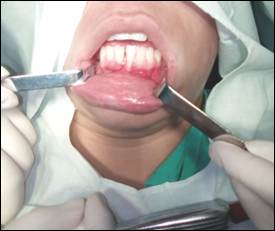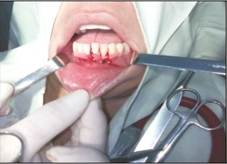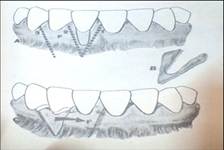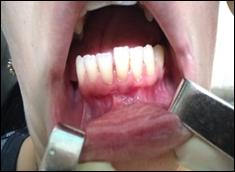Mi SciELO
Servicios Personalizados
Articulo
Indicadores
-
 Citado por SciELO
Citado por SciELO
Links relacionados
-
 Similares en
SciELO
Similares en
SciELO
Compartir
Revista de Ciencias Médicas de Pinar del Río
versión On-line ISSN 1561-3194
Rev Ciencias Médicas vol.27 no.3 Pinar del Río mayo.-jun. 2023 Epub 01-Mayo-2023
Articles
Plastic surgery in localized periodontal recession type 1 of Cairo
1University of Medical Sciences of Pinar del Río. Stomatology Teaching Clinic "Antonio Briones Montoto". Pinar del Río, Cuba.
2University of Medical Sciences of Pinar del Río. Stomatology Teaching Clinic "José Martí", Consolación del Sur. Pinar del Río, Cuba.
3University of Medical Sciences of Pinar del Río. "5 de septiembre" Community Polyclinic, Consolación del Sur. Pinar del Río, Cuba.
Introduction:
periodontal recession is a frequent affection of the periodontium. It is the exposure of the root surface due to the apical displacement of the gum. Its incidence varies from 8 % in children to 100 % after 50 years of age. It affects the esthetics and function of the tissues; it is currently a reason for patients and professionals to visit the dentist. Periodontal plastic surgery is chosen as a plausible solution. This case was attended at the Antonio Briones Montoto Stomatological Clinic in Pinar del Río in 2018, with the aim of reporting the treatment and long-term evolution of a patient with localized periodontal recession type 1 of Cairo and Miller class II.
Case presentation:
female patient, white skin, 25 years of age with a history of good health who referred root denudation of the lower left central incisor, which affects her esthetics and tooth brushing. Vigorous horizontal brushing with a hard toothbrush and abrasive toothpaste was detected, as well as a deleterious habit of protractile tongue, migration of the gum towards the apical in 31, which exposed the dental root 3 mm and pointed interproximal papillae with no affectation. X-rays showed no periodontal destruction in the interdental area. Correction and control of tooth brushing and deleterious habit was carried out; periodontal plastic surgery was chosen by means of lateral pedicled graft.
Conclusions:
The periodontal recession was eliminated, the patient's esthetics was restored and the attached gingiva was functional, a result that has remained in the long term.
Key words: PERIODONTAL RECESSION; TREATMENT; SURGERY; PERIODONTICS; DENTISTRY
INTRODUCTION
Periodontal recession without the presence of inflammatory processes has been widely studied and different investigators differ as to its etiology and classification.1,2,3
Gottlieb, in 1921, proposed that it could be physiological, then it was associated to insertion of braces in the marginal gingiva, presence of a thin external osseous lamina, inadequate height of inserted gingiva, traumatic horizontal tooth brushing, bad dental position and harmful occlusal forces with a slow and prolonged action on the vestibular external lamina.4
The thickness of the gingiva is thin, thin, smooth textured, pale, with elongated and pointed interdental papillae. If the proximal surfaces are involved, spaces are created where plaque accumulates.2
Miller in 1993 classifies it according to its extension in:
Class I: retraction of marginal tissues that does not extend to the mucogingival junction. There is no periodontal destruction in the interdental area.
Class II: retraction of marginal tissues extending to or beyond the mucogingival junction. No periodontal destruction in the interdental area.
Class III: retraction of marginal tissues extending to or beyond the mucogingival junction. There is periodontal destruction in the interdental area or there is dental malocclusion.
Class IV: retraction of marginal tissues extending to or beyond the mucogingival junction. Periodontal destruction in the interdental area or severe dental malocclusion.
Cairo in 2011 classifies it as Type 1: Gingival recession without loss of interproximal junction. The proximal amelocemental boundary is not visible.
Type 2: Gingival recession with loss of interproximal attachment. The amount of proximal attachment loss is equal to or less than the amount of vestibular attachment loss.
Type 3: Gingival recession with interproximal attachment loss. The amount of proximal attachment loss is greater than the amount of vestibular attachment loss.(3, 4)
At the origin of periodontal recession is dental bacterial biofilm and its consequent gingival inflammation, traumatic occlusion, trauma from brushing or abnormal insertion of the labial frenulum and local anatomical features such as tooth positioning, gingival margin, height of the keratinized mucosal band and underlying bone tissue.5
Correction of these disorders in most cases requires surgical treatment. From simply removing braces or using free autografts to more complex procedures based on Guided Tissue Regeneration, or the use of allodermal matrices.6,7
The flap is one of the most up-to-date treatments used in periodontology. Depending on the position of the flap at the end of the surgical procedure:
a) The non-displaced flap is placed in the position it had before surgery.
b) The displaced flap can be placed apical, coronal or lateral with respect to its original position.8
The lateral sliding flap, currently known as laterally placed pedicled graft, is an effective technique to cover isolated retractions of teeth and widen the attached gingiva, the donor area must be periodontally healthy and with an adequate anteroposterior thickness. The vestibule should be normal or deep, without previous surgical deepening, single tooth recession not exceeding 5 mm, the patient should not have systemic diseases that compromise healing, preferably non-smoking. Contraindicated in thin and edematous gums, if the donor area is diseased, malpositioned teeth.(9, 10)
Recent reports indicate that there is a substantial increase in the prevalence of recessions in the world population.11
Other studies carried out in different parts of the world report a wide range of values; in individuals under 20 years of age the prevalence is between 1 and 19 %, in adults over 30 years of age it is between 20 % and 75 %; and it reaches 100 % in adults over 50 years of age.12
In Cuba, some studies also confirm this. One carried out in Mayabeque reported an increase in periodontal recession in adult patients between 45 and 55 years of age; in another developed in Matanzas, it represented 26,9 % of mucogingival disorders.5,6
In Pinar del Río there is no published data on the subject, which, together with the requirements present in the clinical case, was the motivation to perform this periodontal plastic surgery.
PRESENTATION OF THE CASE
Female patient, white, 25 years old, with a history of good general and periodontal health, who came to the periodontics office of the ¨Antonio Briones Montoto¨ Stomatology Clinic, concerned about root denudation of the lower left central incisor, which affects her esthetics and tooth brushing.
She refers to vigorous horizontal brushing with a hard toothbrush and abrasive toothpaste; a deleterious habit of protractile tongue is detected. Apical migration of the gum is observed in 31, exposing the dental root 3 mm and extending to the mucogingival junction, with pointed interproximal papillae without affectation. X-rays show that there is no periodontal destruction in the interdental area. All of the above corresponds to a localized periodontal recession, Cairo Type 1 and Miller Class II, (Fig. 1).

Fig 1 Localized periodontal recession. The Antonio Briones Montoto Stomatological Clinic in Pinar del Río in 2018.
In the initial treatment, tooth brushing was corrected and controlled by instructing her on tooth brushing according to modified Stillman, with a soft cell brush, preferably using dental gel. The protractile tongue was treated with myotherapy for three weeks. Blood complements were indicated prior to periodontal surgery, all in normal parameters. Periodontal plastic surgery was chosen specifically a lateral pedicled graft. Tissue was taken from the left lateral zone to the recession (donor zone) and rotated towards the recession, guaranteeing the vascular supply of the flap. Suspensory sutures were performed (Fig. 2).
For a better visualization, Fig. 3 represents the laterally placed pedicled graft as described by Glickman.13
The area was covered with QUIRUCEM surgical cement and it was indicated not to brush the operated area, cold packs outside the face during the first 24 hours, analgesic if pain, soft diet and the suture was removed after 10 days.
DISCUSSION
Periodontal recession is treated by means of a wide variety of surgical techniques, with the aim of first gaining keratinized gingiva and then trying to achieve root coverage.4,5
In choosing the surgical technique, factors such as the patient's esthetic expectations, the width and length of the interdental tissue, the depth of the vestibule, the presence of frenulae, the presence or absence of keratinized tissue adjacent to the tissue and the size of the recession must be considered.10
In the present clinical case the risk factors that produced localized periodontal recession were improper brushing and protractile tongue. These factors together with the presence of calculus were the predominant ones in the study of Diaz Fabregat.8
The laterally placed pedicled graft is an effective technique to cover isolated tooth recessions and to obtain a functionally satisfactory attached gingival area in the recession zone, guaranteeing adequate healing and the morphology of the donor area.4
In this clinical case the morphological characteristics of the transplanted tissue did not change during the three years of evolution. The flap was attached to the connective tissue bordering the root. It adhered so firmly to the root that it prevented the introduction of a periodontal probe. In the flap donor area, repair and restoration of gingival health and contour were observed. The best results are obtained with narrow and long gingival defects as in this clinical case.
Similar results were obtained by Romero,7 and Cruz,9 in the surgical techniques performed. The patient has been maintained in supportive periodontal therapy after medical discharge, with check-ups every three to six months. With three years of satisfactory evolution, 100 % of the root surface is covered and the patient reports a high degree of satisfaction. Similar results coincide with Sarduy,10 and Urtubia,14 where both patients maintained the root surface covered in the long term and showed a high degree of satisfaction.
CONCLUSIONS
In this clinical case, traumatic brushing and protractile tongue habit were the causes of periodontal recession, so it was necessary to give oral hygiene instruction in the first instance and correction of the habit. After surgery a 100 % root coverage was achieved and in the long term it remains what was achieved with a gain of keratinized gingiva. Aesthetics and proper function were restored. The favorable result in a periodontal surgery of this type not only depended on the success of the surgery but also on the postoperative management that the patient had carried out.
BIBLIOGRAPHIC REFERENCES
1. Huertas Campos MC, Coronado López SL, Tovar Zevallos MA, Morzán Valderrama EJ, Noriega Castañeda JR. Manejo interdisciplinario: ortodoncia osteogénica periodontalmente acelerada en paciente con recesión gingival. Reporte de caso. Odontol sanmarquina [Internet]. 2019 [citado 24/11/2022]; 22(2): 148-58. Disponible en: Disponible en: https://revistasinvestigacion.unmsm.edu.pe/index.php/odont/article/view/16228/14050 1. [ Links ]
2. Jach Ravelo M, Acosta Acosta N, Jach Ravelo M, Hernández Núñez A. La recesión periodontal en el municipio Güines del año 2015 al 2018. Facultad de Ciencias Médicas de Mayabeque. I Jornada Científica Virtual CaliMay 2020 [Internet]; 2020 [citado 24/11/2022]. [aprox. 10 p.]. Disponible en: Disponible en: http://www.calimay2020.sld.cu/index.php/calymay/2020/paper/view/125/112 2. [ Links ]
3. Hernández Luna JM, Alonso Domínguez L, Frías Velázquez JF. Comparación de la clasificación de recesiones periodontales de miller y cairo. Ventajas y limitaciones. La Habana: Congreso Internacional Estomatología 2020 [Internet]; 2020 [citado 24/11/2022]. [aprox. 9 p.]. Disponible en: Disponible en: http://www.estomatologia2020.sld.cu/index.php/estomatologia/2020/paper/view/335/356 3. [ Links ]
4. Colectivo de autores. Compendio de Periodoncia. La Habana: Editorial Ciencias Médicas; 2017. p. 13, 282-99. [ Links ]
5. Cabrera Zamora SL, Jiménez Guevara DM, Fernández Peña GE, Pardías Milán LC. Recubrimiento radicular con técnica de tejido conectivo subepitelial combinado con colgajo deslizado coronalmente. Multimed [Internet]. 2017 [citado 24/11/2022]; 21(1): [aprox. 7 p.]. Disponible en: Disponible en: http://www.revmultimed.sld.cu/index.php/mtm/article/view/468/770 5. [ Links ]
6. Brito Pérez K, Cruz Morales R, Caballero López D. Trastornos mucogingivales y su tratamiento, cinco años de seguimiento en pacientes matanceros. Rev Med Electrón [Internet]. 2017 [citado 24/11/2022]; 39(2): 269-79. Disponible en: Disponible en: https://www.medigraphic.com/cgi-bin/new/resumen.cgi?IDARTICULO=72444 6. [ Links ]
7. Romero Pérez YY. Reporte de un caso clínico diagnóstico y tratamiento de cirugía plástica periodontal atendido en la clínica docente asistencial. [Tesis en Internet]. Perú: Universidad Peruana Los Andes; 2020 [citado 24/11/2022]. [aprox. 41 p.]. Disponible en: Disponible en: https://repositorio.upla.edu.pe/handle/20.500.12848/1616 7. [ Links ]
8. Díaz Fabregat B, Brito González AL, Gountán Quintana N. Recesión periodontal en pacientes del municipio Rodas. Cienfuegos, 2016-2017. MediSur [Internet]. 2018 [citado 24/11/2022]; 16(3): 392-8. Disponible en: Disponible en: http://scielo.sld.cu/pdf/ms/v16n3/ms07316.pdf 8. [ Links ]
9. Cruz Morales R, Caballero López D. Injerto de tejido conectivo subepitelial y colgajo reposicionado coronal modificado para tratamiento de recesiones periodontales. Rev Cubana de Obstetricia y Ginecología[Internet]. 2019 [citado 24/11/2022]; 45(1): [aprox. 13 p.]. Disponible en: Disponible en: http://scielo.sld.cu/pdf/est/v56n4/1561-297X-est-56-04-e2137.pdf 9. [ Links ]
10. Sarduy Bermúdez L, González Valdés Y, Barreto Fiu EE, Corrales Álvarez M. Tratamiento de recesiones periodontales con injerto libre y colgajo de reposición coronal más tejido conectivo. Medicent Electrón [Internet]. 2018 [citado 24/11/2022]; 22(3): 218-27. Disponible en: Disponible en: https://www.medigraphic.com/pdfs/medicentro/cmc-2018/cmc183d.pdf 10. [ Links ]
11. Cuesta Benavides JS. Prevalencia de recesión gingival y su asociación con el biotipo periodontal en adolescentes de la Unidad Educativa “Cardenal Carlos María de la Torre” del Quinche año 2017. [Tesis en Internet]. Ecuador: Universidad Central de Ecuador. Facultad de Odontología; 2017 [citado 24/11/2022]. [aprox. 130 p.]. Disponible en: Disponible en: http://www.dspace.uce.edu.ec/handle/25000/13750 11. [ Links ]
12. Navarrete Burgos DI, Torres Vargas AV. Factores de riesgo de la recesión gingival en adultos y su tratamiento. [Tesis en Internet]. Ecuador: Universidad de Guayaquil. Facultad de Odontología; 2018 [citado 24/11/2022]. [aprox. 136 p.]. Disponible en: Disponible en: http://repositorio.ug.edu.ec/handle/redug/33783 12. [ Links ]
13. Carranza FA. Cirugía mucogingival. En: Carranza FA. Periodontología clínica de Glickman. 5a. Ed. La Habana: Editorial Pueblo y Educación; 1983. p. 923. [ Links ]
14. Urtubia Manríquez C, García Izquierdo C, Alarcón Azócar C. Manejo ortodóncico-periodontal de recesión gingival. ROB [Internet]. 2020 [citado 24/11/2022]; 4(2): 38-44. Disponible en: Disponible en: http://revistas.unjbg.edu.pe/index.php/rob/article/view/961 14. [ Links ]
Received: December 17, 2022; Accepted: January 29, 2023











 texto en
texto en 





